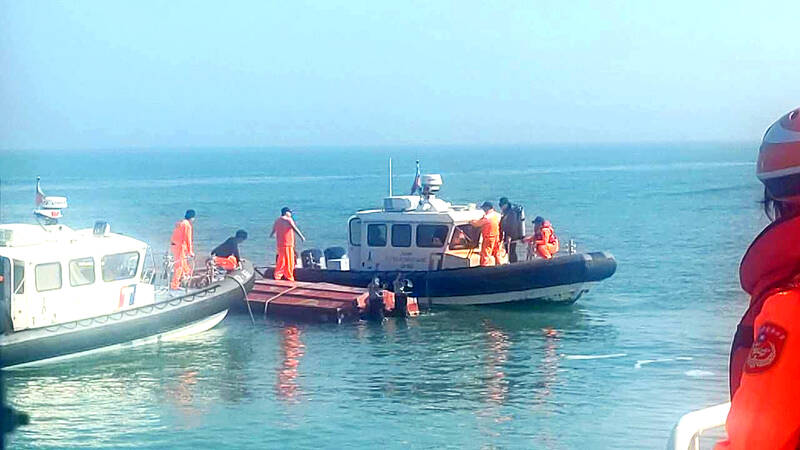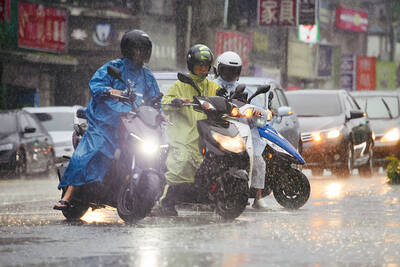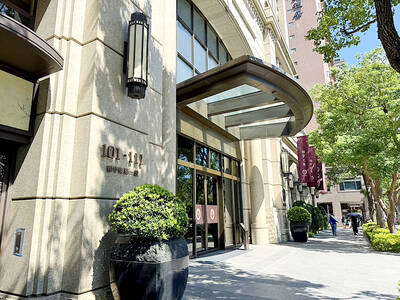The Mainland Affairs Council (MAC) yesterday said it was regrettable that two Chinese men had died the day before when their speedboat capsized during a chase by the coast guard in waters off Kinmen County.
In a statement, the council said it supports the efforts of Taiwanese authorities to carry out their duties in accordance with the law.
An initial investigation has indicated that the coast guard officers were legally performing their duties and had not erred in any way, the MAC said.

Photo courtesy of the Coast Guard Administration
It was regrettable that two of the four Chinese men on the boat had died in the accident, it said, adding that China should take effective measures to restrict illegal activities by its nationals in Taiwanese waters.
Chinese fishing vessels have been intruding into Taiwan’s restricted or prohibited waters for a while to poach high-priced fish, which has seriously intruded on the rights and interests of Taiwanese fishers and residents on nearby islands, the agency said.
Some Chinese fishers have also been caught using poison and explosives to catch fish near Taiwan, and have been polluting the sea, the MAC said.
Taiwan has repeatedly urged China to conduct better oversight of its people, but those calls have been fruitless, the agency said.
MAC Minister Chiu Tai-san (邱太三) yesterday said that the Coast Guard Administration (CGA) reported details of the accident to Kinmen prosecutors and would inform the Chinese side of the investigation’s findings.
Separately, Ocean Affairs Council Minister Kuan Bi-ling (管碧玲) yesterday said that the CGA is not at fault, as the speedboat not only entered off-limits areas, but also lacked a name, certification or registration.
The CGA patrols in two circles — the outer circle, which is considered restricted, and the inner circle, which is off-limits to non-Taiwanese ships, Kuan said.
Coast guards on either side of the Strait would not hesitate to detain such a ship, she added.
The CGA has contacted the families of the deceased to offer assistance, she said.
Wednesday’s accident occurred 1.1 nautical miles (2km) east of Kinmen County’s Beiding Island (北碇) at 1:45pm, when a Chinese speedboat with four people on board was spotted.
As coast guard vessels approached to carry out an inspection, the speedboat tried to flee and capsized while zigzagging across the water.
All four men on the boat fell overboard and were picked up by the coast guard.
Two of them were taken to hospital, but were pronounced dead after efforts to resuscitate them failed.
Later on Wednesday, China’s Taiwan Affairs Office spokesperson Zhu Fenglian (朱鳳蓮) issued a statement condemning Taiwan over the deaths.
Such “rude and dangerous” actions during the Lunar New Year holiday have hurt the feelings of the people on both sides of the Taiwan Strait, Zhu said.
CGA data showed that from July 2016 to November last year, it took actions against illegal Chinese dredgers 20 times, confiscated 16 ships and recorded 25,000 tonnes of illegally dredged sand.
Also during that time, the agency drove off 9,100 Chinese fishing ships that had illegally crossed into Taiwanese waters, confiscating 400 and expropriating 80, while handing out fines totaling NT$280 million (US$8.9 million), CGA data showed.

The combined effect of the monsoon, the outer rim of Typhoon Fengshen and a low-pressure system is expected to bring significant rainfall this week to various parts of the nation, the Central Weather Administration (CWA) said. The heaviest rain is expected to occur today and tomorrow, with torrential rain expected in Keelung’s north coast, Yilan and the mountainous regions of Taipei and New Taipei City, the CWA said. Rivers could rise rapidly, and residents should stay away from riverbanks and avoid going to the mountains or engaging in water activities, it said. Scattered showers are expected today in central and

COOPERATION: Taiwan is aligning closely with US strategic objectives on various matters, including China’s rare earths restrictions, the Ministry of Foreign Affairs said Taiwan could deal with China’s tightened export controls on rare earth metals by turning to “urban mining,” a researcher said yesterday. Rare earth metals, which are used in semiconductors and other electronic components, could be recovered from industrial or electronic waste to reduce reliance on imports, National Cheng Kung University Department of Resources Engineering professor Lee Cheng-han (李政翰) said. Despite their name, rare earth elements are not actually rare — their abundance in the Earth’s crust is relatively high, but they are dispersed, making extraction and refining energy-intensive and environmentally damaging, he said, adding that many countries have opted to

FORCED LABOR: A US court listed three Taiwanese and nine firms based in Taiwan in its indictment, with eight of the companies registered at the same address Nine companies registered in Taiwan, as well as three Taiwanese, on Tuesday were named by the US Department of the Treasury’s Office of Foreign Assets Control (OFAC) as Specially Designated Nationals (SDNs) as a result of a US federal court indictment. The indictment unsealed at the federal court in Brooklyn, New York, said that Chen Zhi (陳志), a dual Cambodian-British national, is being indicted for fraud conspiracy, money laundering and overseeing Prince Holding Group’s forced-labor scam camps in Cambodia. At its peak, the company allegedly made US$30 million per day, court documents showed. The US government has seized Chen’s noncustodial wallet, which contains

SUPPLY CHAIN: Taiwan’s advantages in the drone industry include rapid production capacity that is independent of Chinese-made parts, the economic ministry said The Executive Yuan yesterday approved plans to invest NT$44.2 billion (US$1.44 billion) into domestic production of uncrewed aerial vehicles over the next six years, bringing Taiwan’s output value to more than NT$40 billion by 2030 and making the nation Asia’s democratic hub for the drone supply chain. The proposed budget has NT$33.8 billion in new allocations and NT$10.43 billion in existing funds, the Ministry of Economic Affairs said. Under the new development program, the public sector would purchase nearly 100,000 drones, of which 50,898 would be for civil and government use, while 48,750 would be for national defense, it said. The Ministry of